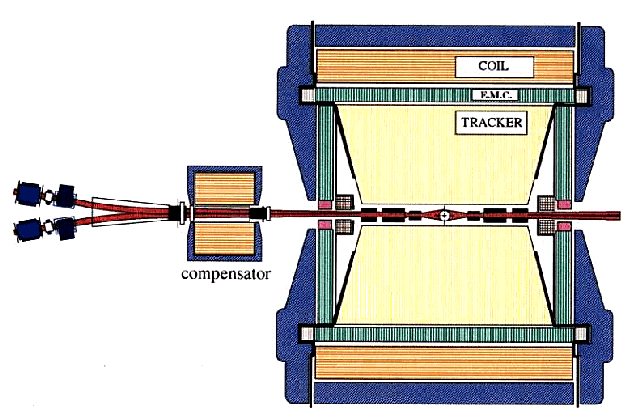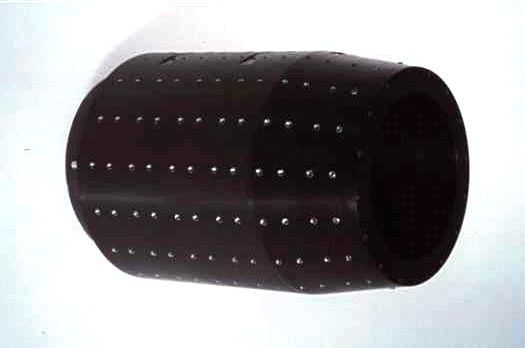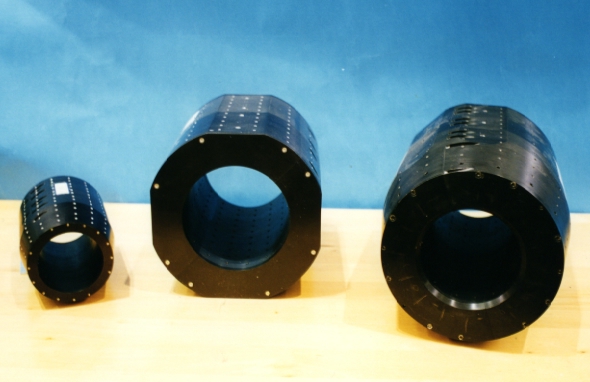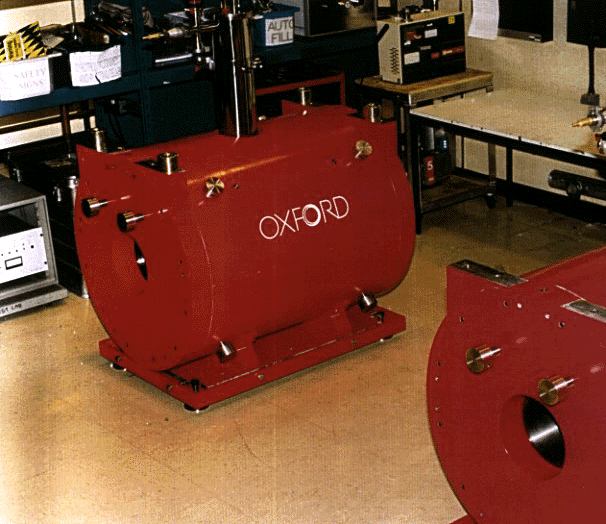
Schematics of the KLOE detector with the solenoid and permanent magnet
quadrupoles.

Schematics of the KLOE detector with the solenoid and permanent magnet
quadrupoles.
The KLOE experiment is mainly dedicated to the study of CP violation in the decay of the Phi resonance and requires the maximum possible free solid angle around the IP. This requirement is in conflict with the necessity of putting the strong focusing quadrupoles of the low-beta insertion as close as possible to the interaction point to avoid large contributions to the aperture and the chromaticity of the ring. For this reason a very compact solution has been adopted for these quadrupoles, by realising them with permanent magnets: in this way the magnetic structure of the machine is completely contained within two narrow cones of 9 degrees half aperture around the vacuum chamber axis, and the acceptance of the experiment is near 99%. Moreover, the iron of conventional quadrupoles represents a strong perturbation to the solenoidal field required for the experiment, while permanent magnets do not interfere with it. In the KLOE interaction region there are six such quadrupoles, three on each side of the IP. In the FINUDA interaction region, due to the shorter length of the solenoidal, there are only four permanent magnet quadrupoles.
A third layout for the interaction regions, called the DAY-ONE structure has also been designed to operate without solenoidal fields: it will be used during the commissioning of the collider, and it is realised with conventional quadrupoles.

Permanent magnet quadrupole QF1.

The three permanent magnet quadrupoles of the KLOE interaction region triplet
The design strategy of DAFNE foresees flat beams to overcome the difficulties which may come from the crossing angle at the IP. The solenoidal fields of the detectors are a strong source of coupling and must therefore be carefully compensated to avoid the growth of the vertical beam size. The compensation is achieved by means of a couple of superconducting solenoids, one on each side of the experimental detectors, near the splitters, with a longitudinal field opposite to the main solenoid one and with the same total integrated field. In addition, since the solenoid field rotates the plane of betatron oscillation proportionally to its field integral, the permanent magnet quadrupoles must be rotated accordingly. A complicated support, allowing a rotational degree of freedom for the quadrupole triplets is foreseen for fine adjustment of the coupling.

Superconducting compensator solenoid
The overall focusing effect of the low-beta quadrupoles and fringing field of the solenoids is the same for the KLOE, FINUDA and DAY-ONE insertions. This helps a lot in changing the operation mode of the collider from one to another configuration. In particular, the low- beta quadrupoles and the vacuum vessel section around the IP are completely embedded into the experimental detectors. If one of the detectors needs to be taken away from the beamline for maintenance, it is possible to replace it with the corresponding DAY-ONE straight section without changing the optics of the remaining part of the collider.
One of the most critical items of the whole project is the KLOE vacuum vessel near the IP. It is important that the Kshort coming from the decay of the F resonance cross the minimum possible amount of material to avoid regeneration. For this reason the first idea for the vacuum chamber shape near the IP was a sphere with a radius large enough for the decay of the Kshort (~10 cm). However, it appeared immediately clear that such a shaped chamber could trap R.F. fields induced by the high current beam, leading to R.F. losses and overheating. It was therefore decided to shield the sphere from the beam by means of an extremely thin (50 microns) beryllium cylinder of the same radius of the beam pipe outside the IP. The sphere is also made of beryllium (500 microns thickness to minimise the radiation lengths seen by the other decay particles). Prototypes of this vessel sections are being developed by specialised factories.
Beam diagnostics in the interaction region is also a critical item for the overall reliability of the collider. A system of directional striplines is used to detect the position of the electron and positron beams even if they travel in the same vacuum chamber, while special button pickups are used near the splitter, where the distance between the two beams is sufficient to allow an efficient independent position detection. The luminosity monitor described in the Main Rings section will also be used to optimise the superposition of the beams.
The main source of particle losses in the DAFNE Main Rings is the Touschek effect, namely intrabeam scattering between particles in the same bunch, which leads to an energy change of the scattered particles. This effect limits the beam lifetime to ~2 hours. The lattice structure is such that all the particles scattered in the achromat upstream the interaction point are deflected by the second bending magnet and reach their maximum oscillation amplitude in the detector region. They constitute therefore a potential source of severe background to the experiment. In order to avoid this intrinsic drawback of the collider lattice, a system of adjustable scrapers has been designed, which trap the scattered particles before the splitter, at the price of a small reduction of beam lifetime.
The DAY-ONE interaction region structure, consisting of 7 normal conducting quadrupoles, is now in operation for the commissioning phase of the Main Rings.
The cam systems for the permanent magnet quadrupoles rotation and alignment of the KLOE interaction region is ready. The whole system of the cylindrical support for the permanent magnet quadrupoles with their positioning system and the KLOE Q-calorimeter is being assembled.The vacuum vessel around the interaction point consists of a 500 micron spherical beryllium chamber and an internal 50 micron beryllium shield to decrease the parasitic RF losses of the beam.After a long period of R&D, the thin shield has been successfully realized, while the sphere is under construction. Due to the tight schedule of the experiment, it has been decided to start with a cylindrical beryllium chamber of the same thickness. The delivery of this chamber is expected by the end of April.
The support of the permanent magnet quadrupoles and their cam system for alignment and rotation into the detector for FINUDA is almost ready at the factory. The permanent magnet quadrupoles have been built and will be delivered soon. The beryllium chamber is under construction.